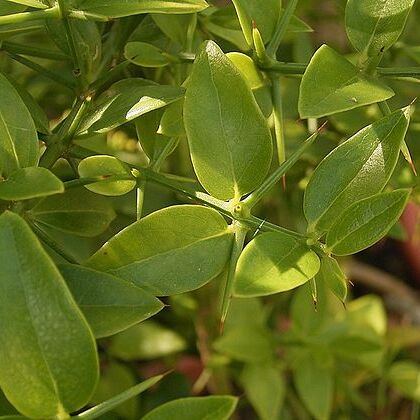Trees or shrubs, unarmed or with axillary spines. Leaves mostly coriaceous, opposite, simple, entire; stipules minute or absent. Flowers regular, hermaphrodite or dioecious, in dense axillary or terminal fascicles or panicles. Calyx-lobes 2–4(–5). Petals 4(–5), imbricate, free or partially connate. Stamens 4(–5), epipetalous or inserted near base of petals and alternate with them; filaments free or connate at base. Anthers 2-thecous; thecae back to back, opening by longitudinal slits. Disk absent or consisting of separate glands between the filaments. Ovary superior, 1–2-locular; style short; ovules 1–2, erect. Fruit a berry or drupe. Seeds without endosperm; embryo with thick cordate cotyledons
Stamens 4, inserted on or near the base of the petals and alternate with them; anthers 2-celled, opening lengthwise
Flowers in dense axillary fascicles or panicles, hermaphrodite or dioecious, actinomorphic
Stamens 4, epipetalous or inserted at base of petals and alternate with them
Seed erect, without endosperm; embryo with thick cordate cotyledons
Inflorescence of dense axillary or terminal fascicles or panicles
Seeds without endosperm; embryo with thick cordate cotyledons
Flowers mostly 4–merous, bisexual or dioecious, actinomorphic
Anthers 2–thecous; thecae opening by longitudinal slits
Ovary 1–2–locular; style short; ovules 1–2, erect
Trees or shrubs, unarmed or with axillary spines
Trees or shrubs, sometimes with axillary spines
Petals 4, imbricate, free or partially joined
Leaves usually coriaceous, opposite, simple
Petals 4, free or shortly united, imbricate
Leaves opposite, simple; stipules minute
Ovary superior, 1–2-celled; style short
Disk absent or of separate glands
Stipules minute or absent
Fruit a berry or drupe
Fruit a berry or drupe
Calyx 3–4-toothed
Ovules 1–2, erect
Calyx–lobes 2–4

